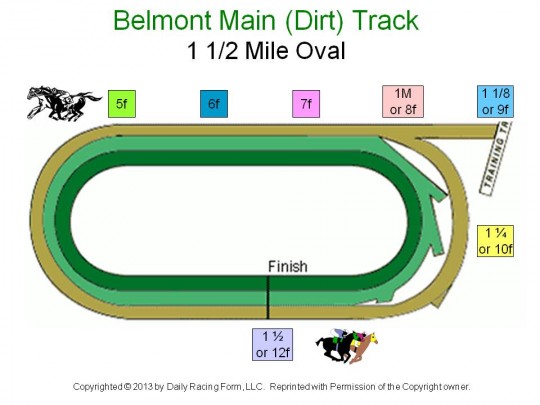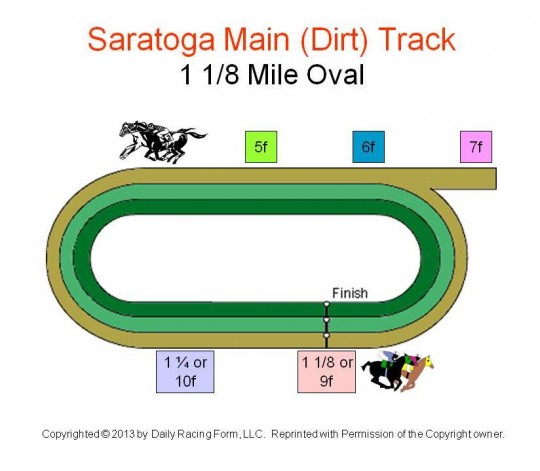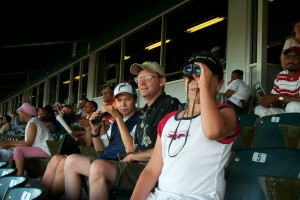From Furlongs to Ovals – How Distances Vary by Racetrack
In an earlier article (What’s a Furlong?) we defined the standard measure of distance in Horse Racing as a furlong. But, how does that furlong translate into races on an actual race track? The first thing you have to realize is that it varies by race track. While the vast majority of race tracks in North America are oval in shape, they are not all the same size, nor the same configuration. It’s kind of like the difference in Major League Baseball parks. Some have a short fence, while others have a big green wall. The number of feet to left, center, and right fields vary. Some ballparks have grass, while others have artificial turf. Many similar variations occur in horse racing.
So let’s start with the racing surface. In North America there are three different types of surfaces; Dirt, Grass, and Synthetic. Most tracks have a “Main” track made of either Dirt or a Synthetic material. Inside the main track can be 0, 1, or 2 Grass (Turf) courses. And, in one instance (Aqueduct) there is a second Dirt track inside of the “Main” dirt track. This post is going to focus on only the “Main” course layouts, and a future post will get into the Turf layouts.
They say a picture is worth a thousand words, so here is a diagram of Saratoga’s Main Track.
The “Main” dirt track is the outer oval in brown, and it measures 1 1/8 mile (9f) in circumference. I’ve added the location of the starting gate (in a box) for each distance from 5f up to 10f. Any race run beyond 9f requires the horses to pass the finish line more than once.
Notice that the Finish line is fixed. While races of different distances begin in different locations, every race at Saratoga ends in the same location. Though this is generally true for all Race Tracks, there are some exceptions at other tracks for specific distances.
Notice that 7f races begin in a chute at the upper right side of the track. Also, notice there is no location for a 1-mile (8f) race at Saratoga.
Actually, Saratoga never runs a race over the Dirt course at 8f or 8.5f. This is because both distances would have to start in the middle of the first turn, and would be unfair to horses in outside post positions.
So let’s contrast Saratoga to the “Green Monster” of Race Tracks … Belmont Park. Belmont has the largest oval by far of any track in North America. I still remember the first time I went to Belmont Park, and I was blown away by how vast and visually stunning the race track is in person.
From the stands it seems like the backstretch is miles away. If you decide to visit Belmont, and you are planning to sit in the grandstand, binoculars are essential. Of course, if you take your kids, as I did in the picture to the side, you end up having to share your binoculars with them!
So here is a diagram of Belmont’s Main Track.

Unlike Saratoga, races of 8f and 8.5f (not shown on diagram) are possible since the track is so large. And races 1 1/2 miles (12f) long, start and end at the same location, the finish line. Which, by the way, happens to be the distance of the third leg of the Triple Crown, The Belmont Stakes.
There will be more in future posts about the configuration of some other popular Race Tracks, and additionally the turf course layouts as well. Later we will utilize this information to discuss handicapping strategies that involve distance, one of my four Basic elements of handicapping.
To see the layout of several other main tracks, including their oval size and length of their stretch runs, click here to view an article on the layout of “Other Major Racetracks in North America”.



6 comments on “From Furlongs to Ovals – How Distances Vary by Racetrack”